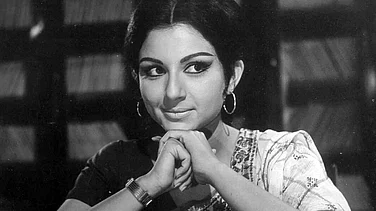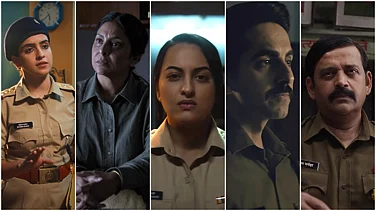Kiran Mohindra is a greying, homely 50-year-old who believes she can paint better than M.F. Husain and the top dozen artists in India. India's top interior decorators and art buyers believe it too, enthusiastically paying her thousands of rupees for the oil canvases she does of cosmetic Rajasthani village belles, Ravi Varma copies or the latest rage: "architectural paintings" of old doorways and stairways.
"All my paintings sell," claims Mohindra who, assisted by half-a-dozen hired artists, produces more than 30 oil paintings a month, besides frescoes, relief work and three-dimensional art. Art dealers, interior decorators and lifestyle store proprietors bear her out: the market—and prices—for pretty, feelgood, made-to-order works is growing at a rate that would make top painters of high art giddy.
"Realistic, ethnic paintings move faster than a Husain or a Souza," agrees art dealer D.V. Chawla, who has been running his own gallery in a five-star hotel in Delhi for over 35 years. "Indians don't like abstract paintings they can't understand," he explains. High art, Chawla points out, "may look good in an art gallery or a business house, but nobody wants to take it home and hang it on their walls, especially if it is grim and dark." Private buyers, on the other hand, are willing to pay anything from Rs 50,000 to Rs 5 lakh for paintings by little-known artists with the skill to paint beautiful figures in 'ethnic' garb. "Beautiful faces with beautiful make-up and beautiful clothes is what Indians find appealing," Chawla tells you.
Popular appeal apart, these painters afford another satisfaction: interactivity. "Sometimes, my clients want the same painting in different colour combination or size. We offer to put them in touch with the artist in that case," he adds.
Buyers can sometimes make the most outrageous of demands. Anjana Kuthiala, a former Miss India who switched from painting dupattas to canvases 10 years ago after seeing a high-priced painting of a beautiful woman in a mirrored dupatta, recalls a buyer who returned one of her paintings of a deadpan beauty in Rajasthani costume because "one of the breasts was lower than the other". Kuthiala obligingly 'corrected' the mismatched bosom for her discriminating buyer. Others want her to include self-portraits or even to make her faces "more realistic". "But when I did the painting of a more plain-faced woman, I found there were no buyers for it, so now I stick to beautiful, cosmopolitan faces which are a mix of the rural and urban—the ideal woman of Indian men's fantasy," says Kuthiala, who counts among her buyers such celebrities as Farooq Abdullah, Jagdish Tytler, Poonam Dhillon and Hema Malini.
Another reason why painters like Kuthiala are becoming Picassos overnight is because of their buyers' faith in vaastu. "My paintings are considered vaastu-friendly," says Kuthiala, referring to the vaastu tenet that pictures on the walls of a home must have pleasant faces in pleasant colours. Kuthiala loved using white in her paintings but stopped when she discovered the colour had no takers.
For the few painters who refuse to be so adaptable, the climb takes years instead of the months it took Kuthiala and other young artists. When Anu Naik moved with her artist husband from Poona to Delhi 37 years ago, she found it hard to sell her art, although they were of charming Rajasthani figures and scenes from everyday life that now fetch over a lakh each."When a businessman commissioned a painting for his boardroom, I accepted the offer. He wanted a scene of an Indian marketplace, with vegetables and fruits, and I spent days sketching in the marketplace before painting it," says Naik. But there are limits: "Buyers sometimes come to me, saying I like your painting, but I'd like this and that, and I tell them, 'Then you paint it.' I need the freedom to paint as I think best."
Flexible creativity is even more valuable for interior decorators. "Art comes last in interior decoration," says Payal Kapoor, a top Delhi-based interior designer. "We have to commission a painting after everything else is in place; it must match the colour scheme and wall size and also the furnishing style." If it's a European-style home, for instance, Kapoor wants Leonardo da Vinci or French impressionist fakes; if it's colonial, it may be a Ravi Varma copy and for an ethnic home, it's either a Mughal miniature or a Rajasthani village woman. And since reputed artists like Naik refuse to paint to order and Kapoor's clients are rich enough to pay for originals instead of prints, she relies on artists like Mohindra to produce copies. "They are as good as originals," says Kapoor, recalling the Ravi Varma painting the artist had executed for her. "It was worth the lakh I paid for it." Congress politician Tytler, proud owner of countless copies of priceless originals, goes even further. "They are better than the originals," he enthuses about the Van Goghs and Ravi Varmas by unknown artists he appoints his living room walls with.
But painters say it takes a lot more than a gift for drawing to perfect this market-friendly art. "In order to be recognised," says Chawla, "an artist needs backing, a good sponsor, and good family connections." Without these, it's either low-paid anonymity or a long, painful climb to the top. "I didn't know the right people," says Naik. "I held a show at Ashoka Hotel but didn't know whom to invite." Her popularity, therefore, grew at snail's pace, mostly among foreigners, and by word of mouth. In contrast, Kuthiala was selling faster than she could paint within a year of her high-society launch in 1991. The secret of her success? Partly, she admits candidly, because of the publicity. "It's important to have important people at an art show," says Kuthiala, who has wooed celebrities like Hema Malini, Rekha and Dimple Kapadia to her exhibition by painting them as The Changing Faces of Indian Beauty.
Other enterprising young artists are using high connections to their own advantage. Laila Khan's maiden show a few months ago in Delhi was not only well-attended—with her father Feroze Khan leading the Khan clan of celebrities and Rekha doing the ceremonies—but was also remarkably successful; nearly half the high-priced paintings were sold before her first show ended. But as Chawla points out, high connections and a glittering launch alone are not sufficient to sell paintings. While there is no similarity between the Kuthiala and Khan's paintings, their popularity lies in their ability to paint what is now in fashion. Kuthiala especially, as Chawla says, "has the knack of making beautiful faces that sell". Khan's paintings of broken Greek columns set in timber frames fit in well with the current fashion of "architectural" paintings in India's rich homes.
"There is a market for pretty, touristy pictures, so who are we to judge it?" says Satish Gupta, role model for the new breed of parlour painters.Gupta, who switched from abstract art to figurative over two decades ago, was among the first to celebrate the beauty of Rajasthan's Thar desert and its tribes. He is now resigned to being endlessly copied by the young and ambitious artists. "Don't senior artists too cash in on anything current? Both Husain and Anjolie are where they are because of figurative art. It's what sells in India." Agrees Naik: "Real artists shouldn't have to compromise, but real artists have to eat." So who's quarrelling if the bread is coming in thickly buttered?
Parlour Painters
A young, ambitious breed which excels in pretty pictures gives top artists a run for their money

Parlour Painters
Parlour Painters
Published At:
MOST POPULAR
WATCH
MORE FROM THE AUTHOR
×


















